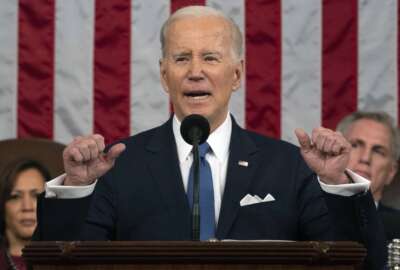

The Commerce Department's inspector general is hiring fast to oversee billions of dollars in CHIPS Act spending.
The Commerce Department’s inspector general is adding staff and gearing up to oversee a massive influx of funding aimed at revitalizing the U.S. semiconductor industry, as lawmakers look to the IG to keep an eye on the biggest industrial policy initiative in decades.
The Creating Helpful Incentives to Produce Semiconductors (CHIPS) and Science Act signed into law by President Joe Biden last August includes $50 billion for a suite of programs designed to boost U.S. semiconductor research and manufacturing, including $39 billion for expanding commercial production.
In late February, the CHIPS Program Office released its first notice of funding opportunity as it prepares for the initial distribution of grants under the program.
Peggy Gustafson, Commerce’s IG, described her office’s preparation for the CHIPS Act during a March 23 House Appropriations Commerce, Justice, and Science Subcommittee hearing.
“It’s unlike the other programs that exist already in Commerce and I would hazard to say it’s unlike really any other program that the federal government is undertaking right now,” Gustafson said. “It’s very unique.”
The CHIPS and Science Act included $25 million over five years for the Office of Inspector General (OIG) to conduct oversight of the program. It also included $22 million for the OIG to oversee the Public Wireless Supply Chain Innovation Fund.
Gustafson’s office currently sits at just under 200 staff, but it’s funded to grow to 237 positions by the end of fiscal 2023, she told lawmakers. The 2024 budget request seeks to grow the OIG further to 252 staff.
The office is building out two teams to oversee CHIPS spending, Gustafson said. In addition to auditors, the OIG is looking for individuals with a technical background in semiconductor technologies, she added.
Gustafson’s prepared testimony notes that the OIG has already identified several preliminary challenges for Commerce’s administration of the CHIPS funding, “including managing its workforce to meet new demands, as well as implementing controls and oversight for this new program and its corresponding funding.”
In addition to the CHIPS Act funding, Commerce’s National Telecommunications and Information Administration is also overseeing $48 billion in funding to improve broadband access as part of the Infrastructure Investment and Jobs Act of 2021.
With the infusion of contracts and grants funding at Commerce in recent years, the OIG has named contracts and grants management as a “top challenge” for the agency, Gustafson testified.
Hiring and retaining experienced acquisition staff is one of the challenges, she said, while OIG also identified “significant vulnerabilities in how the department manages contract and grant file documentation, which could expose the department to substantial financial losses.”
Commerce also oversaw aspects of the COVID-19 response under the $2 trillion Coronavirus Aid, Relief, and Economic Security (CARES) Act.
Contract and grant fraud now account for 65% of OIG’s cases, Gustafson testified. Prior to fiscal 2021, they represented less than 40%.
“Recognizing the risks associated with a significant influx of funding, OIG is also proactively providing guidance on how to prevent, detect, and resolve contract and grant fraud,” she added.
Gustafson said the OIG relies on data analytics and data mining to look for “fraud indicators,” leading to more proactive investigations.
Meanwhile, the forthcoming spending on CHIPS Act spending and broadband access grants, respectively, will pose different challenges to oversight.
While the [Infrastructure Investment and Jobs Act (IIJA)] broadband spending will be spread out across hundreds of projects across different communities, the CHIPS Act funding is likely to have “a much smaller set of recipients of a tremendous amount of money,” Gustafson noted.
“What’s crucial for us is going to be getting the word out and building those relationships, because where we’re going to see the issues literally is on the ground in the areas about whether it’s actually working,” she said. “It’s a completely different set of risk factors. Our goal is to perform the oversight as it’s happening so we’re looking at the implementation and then the delivery and whether it’s really working.”
Copyright © 2025 Federal News Network. All rights reserved. This website is not intended for users located within the European Economic Area.
Follow @jdoubledayWFED


